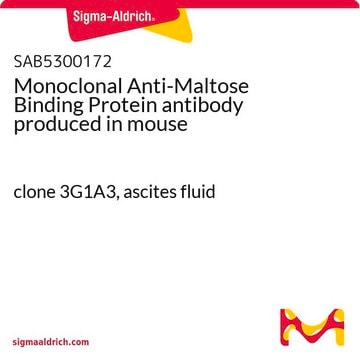F2555
Rabbit Monoclonal ANTI-FLAG® Clone SIGI-25
clone SIG1-25, ascites fluid
Synonyme(s) :
Anti-ddddk, Anti-dykddddk
About This Item
Produits recommandés
Source biologique
rabbit
Niveau de qualité
Conjugué
unconjugated
Forme d'anticorps
ascites fluid
Type de produit anticorps
primary antibodies
Clone
SIG1-25, monoclonal
Technique(s)
immunocytochemistry: 1:125-1:250 using transiently transfected cells expressing FLAG (sequence at the N-terminus)-tagged protein fixed with paraformaldehyde/Triton™ X-100
indirect ELISA: suitable
western blot: 1:250-1:500 using extracts of transiently transfected cells expressing FLAG (sequence at the N-terminus)-tagged protein
Isotype
IgG
Séquence immunogène
DYKDDDDK
Conditions d'expédition
dry ice
Température de stockage
−20°C
Catégories apparentées
Description générale
Spécificité
Immunogène
Application
- immunofluorescence
- western blot analysis
- immunocytochemistry
- indirect ELISA
Learn more product details in our FLAG® application portal.
Forme physique
Informations légales
Not finding the right product?
Try our Outil de sélection de produits.
Code de la classe de stockage
10 - Combustible liquids
Classe de danger pour l'eau (WGK)
WGK 3
Point d'éclair (°F)
Not applicable
Point d'éclair (°C)
Not applicable
Équipement de protection individuelle
Eyeshields, Gloves, multi-purpose combination respirator cartridge (US)
Certificats d'analyse (COA)
Recherchez un Certificats d'analyse (COA) en saisissant le numéro de lot du produit. Les numéros de lot figurent sur l'étiquette du produit après les mots "Lot" ou "Batch".
Déjà en possession de ce produit ?
Retrouvez la documentation relative aux produits que vous avez récemment achetés dans la Bibliothèque de documents.
Les clients ont également consulté
Contenu apparenté
Protein and nucleic acid interaction reagents and resources for investing protein-RNA, protein-DNA, and protein-protein interactions and associated applications.
Réactifs pour interactions entre protéines et acides nucléiques, ressources permettant d'étudier les interactions protéines/ARN, protéines/ADN et protéines/protéines, et applications associées.
Notre équipe de scientifiques dispose d'une expérience dans tous les secteurs de la recherche, notamment en sciences de la vie, science des matériaux, synthèse chimique, chromatographie, analyse et dans de nombreux autres domaines..
Contacter notre Service technique













